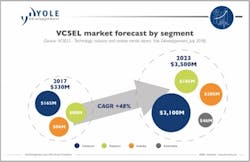Yole says Apple 3D sensing strategy is pushing VCSEL growth
Apple's technical choice directly impacted the vertical-cavity surface-emitting laser (VCSEL) industry and Yole Développement (Yole; Lyon, France) says that the move is creating impressive market figures in its new technology and market report, VCSEL - Technology, Industry and Market Trends: more than 3.3 billion units in 2023 with a 31% compound annual growth rate (CAGR) between 2017 and 2023. This explosion is changing the future of all players of the VCSELs supply chain including: OEMs, integrators, device manufacturers, epi houses, foundries, equipment and material suppliers.
RELATED ARTICLE: Axsun develops tunable VCSEL platform for OCT imaging
The VCSEL industry took a strategic turn last year with the release of the latest iPhone. Indeed the leading smartphones manufacturer, Apple revealed to the entire world a new smartphone with innovative 3D sensing function based on VCSEL technology. The Yole report presents an in-depth analysis of the VCSEL industry with its supply chain and competitive landscape. It exposes a comprehensive review of the main VCSEL applications including in-depth analysis of the consumer and automotive landscapes with 3D sensing, light detection and ranging (lidar), and gas sensing.
The report details VCSEL device market size, broken down by application and segment, and the related MOCVD reactor market. In addition, Yole's analysts bring to light a significant overview of the VCSEL IP landscape. VCSEL manufacturing processes, associated challenges, recent trends and player positioning are also well analyzed. Yole says that 3D sensing--and more--in smartphones will drive the VCSEL market for the next five years.
Data communications was the first industrial application to start integrating VCSELs. Their sweet spot has been in short-distance data communication due to their low power consumption and competitive price compared to edge-emitting lasers (EELs). Driven by the development of datacenters, the VCSEL market and production boomed in the 2000s with the internet's popularity, and then grew steadily. Some new applications for VCSEL emerged, like laser printers and optical mice, but weren’t strong growth drivers.
Only in 2014, almost 20 years since the first use of the technology in datacom, VCSELs started to make their way into high volume consumer smartphones. But this coupling with sensors for proximity sensing and autofocus functions was only the beginning of the VCSEL success story. "In 2017 Apple released the iPhone X, with a 3D sensing function based on this technology," explains Pierrick Boulay, Technology & Market Analyst at Yole. And he explains, “The iPhone X integrates three different VCSEL dies for the proximity sensor and the Face ID module, and made the VCSEL market explode in 2017, propelling overall revenue to about US$330 million."
Good iPhone X sales have now triggered the interest of other smartphone brands in this breakthrough 3D sensing function. Less than one year after the release of Apple’s flagship, its competitors are now following the same trend and starting to integrate 3D sensing technologies. Xiaomi and Oppo were the quickest on the draw, with the Xiaomi Mi8 and the Oppo Find X models presented in the second quarter of 2018. Other leading smartphone players like Huawei, Vivo or Samsung are also expected to integrate VCSELs into their flagship models by 2019.
In this context, the explosion of VCSEL demand initiated in 2017 will persist for the next five years, potentially multiplying the business opportunity more than tenfold. VCSEL market volume is expected to grow from 652 million units in 2017 to more than 3.3 billion units in 2023. This booming trend is likely to trigger interest in VCSEL technology at many industry levels, including OEMs, integrators, device manufacturers, epi houses, foundries, equipment, and material suppliers. To be able to follow this booming demand, more than 100 MOCVD reactors will be needed, which is likely to please companies that supply this equipment, such as Aixtron, Veeco, and Taiyo Nippon Sanso.
Yole expects therefore strong investment and proliferation in the VCSEL industry with the entry of several new players, mostly from the LED industry, whose technology is similar.
Since 2016, Yole analysts’ have already seen some M&A, like ams' acquisition of Princeton Optronics, and Osram's deal for Vixar, and investment in manufacturing expansion or supply chain reinforcement, like Apple investing $390 million in Finisar. Yole expects the bulk of these investments to occur in the coming years. And once VCSEL hype reaches its peak, Yole also expects a necessary consolidation phase with more M&A occurring at all level of the supply chain
SOURCE: Yole Developpement; http://www.yole.fr/VCSEL_IndustryOverview.aspx#.W1qOwcInbDc
About the Author

Gail Overton
Senior Editor (2004-2020)
Gail has more than 30 years of engineering, marketing, product management, and editorial experience in the photonics and optical communications industry. Before joining the staff at Laser Focus World in 2004, she held many product management and product marketing roles in the fiber-optics industry, most notably at Hughes (El Segundo, CA), GTE Labs (Waltham, MA), Corning (Corning, NY), Photon Kinetics (Beaverton, OR), and Newport Corporation (Irvine, CA). During her marketing career, Gail published articles in WDM Solutions and Sensors magazine and traveled internationally to conduct product and sales training. Gail received her BS degree in physics, with an emphasis in optics, from San Diego State University in San Diego, CA in May 1986.
